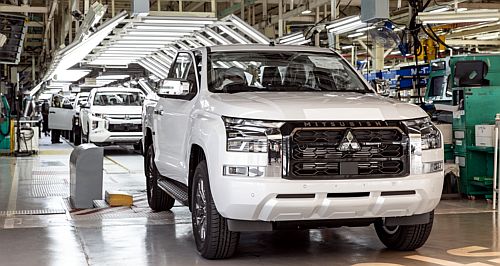Mitsubishi boss predicts Triton supply challenges

MITSUBISHI’S recently released Triton has Australian ute buyers excited. But according to Mitsubishi Motors Australia (MMAL) CEO, Shaun Westcott, shipping, and logistics constraints may affect supply of the all-new model coinciding with its launch in early 2024.
Speaking to Australian journalists gathered in Bangkok, Thailand, for the global debut of the all-new Triton late last month, Mr Westcott said the impact of COVID-19 related global freight movements is far from over, and that the importer is already facing “challenges” six months from Triton’s local debut.
“The challenge that we have right now is, that even as semiconductor prices and supply constraints have dissipated to some degree, logistic (pricing and availability) has picked up and created a headache of its own,” he said.
“With the current lens on where shipping and logistics capacity, and harbours, ports and quarantine limitations are set, there may well be some challenges that are at odds with the vehicle’s arrival, given we are only six months’ out from launching this vehicle.”
Mr Westcott explained that although Australian Triton production slots are confirmed for December, shipping availability at the time is tighter than ever.
Mitsubishi is the third largest vehicle producer in Thailand and the second largest exporter, competing alongside BMW, Ford, GWM, Honda, Isuzu, Mazda, Mercedes-Benz, MG, Nissan, Suzuki, and Toyota for space on roll-on/roll-off (RORO) carriers leaving Thai ports to over 120 international markets.
Twelve per cent of Mitsubishi’s Thai-built exports head to Australia and New Zealand (see full breakdown below).
The manufacturer currently produces some 270,000 vehicles annually (with capacity of up to 424,000 units annually) in Thailand, including the Triton and related Pajero Sport, as well as the Outlander PHEV and Mirage and Attrage light car sold predominantly in Southeast Asia.
All are vying for space on RORO carriers.
“Looking at the current backlogs we are experiencing – and when I see ‘we’ I mean Mitsubishi and multitudes of other manufacturers – across the supply chain, I have a nasty feeling that there may be some supply and logistics challenges with Triton,” he said.
“The problem is not production capacity. It is shipping and logistics.”
Automobile production is Thailand’s third largest industry with annual capacity of more than three million units. More than 520,000 people are employed in vehicle production and assembly.
There are some 19 automotive and eight motorcycle manufacturers with production facilities in Thailand – not to mention an extensive network of more than 1800 OEM and aftermarket component and tyre manufacturers.
Mitsubishi Thailand global exports (FY22*):
|
Region |
Units |
|
Asia/ASEAN |
64,800 |
|
Australia/New Zealand |
32,400 |
|
Central & Latin America/Oceania |
40,500 |
|
Europe |
32,400 |
|
Middle East & Africa |
54,000 |
|
North America |
43,200 |
*Based on FY22 production of 270,000 units.